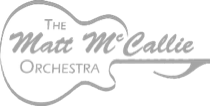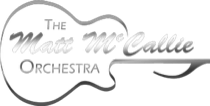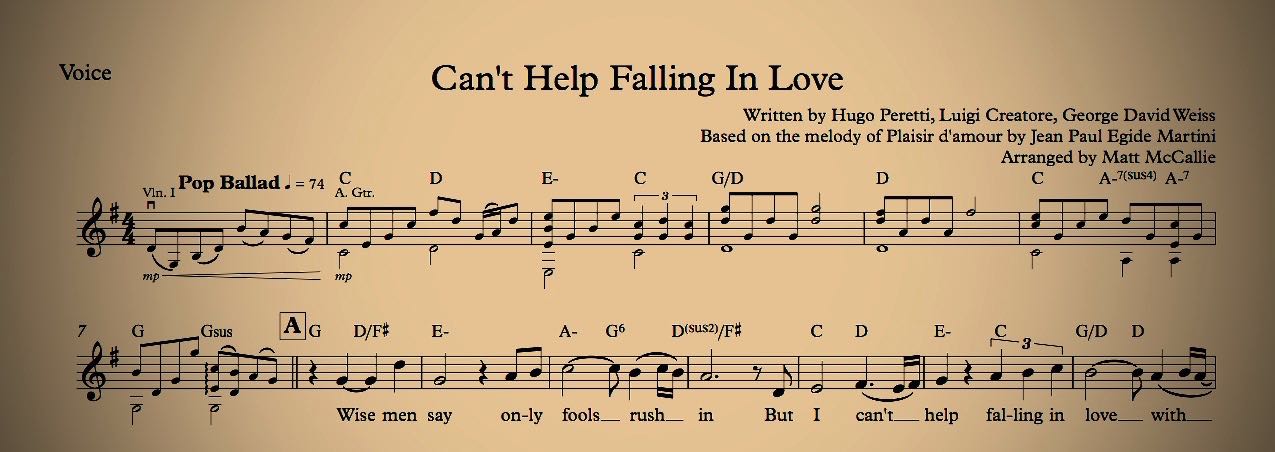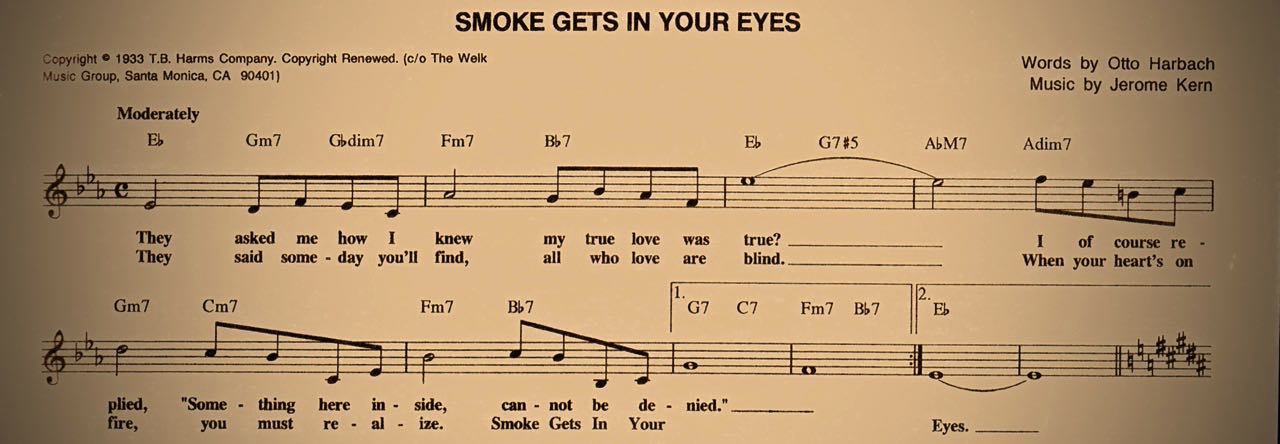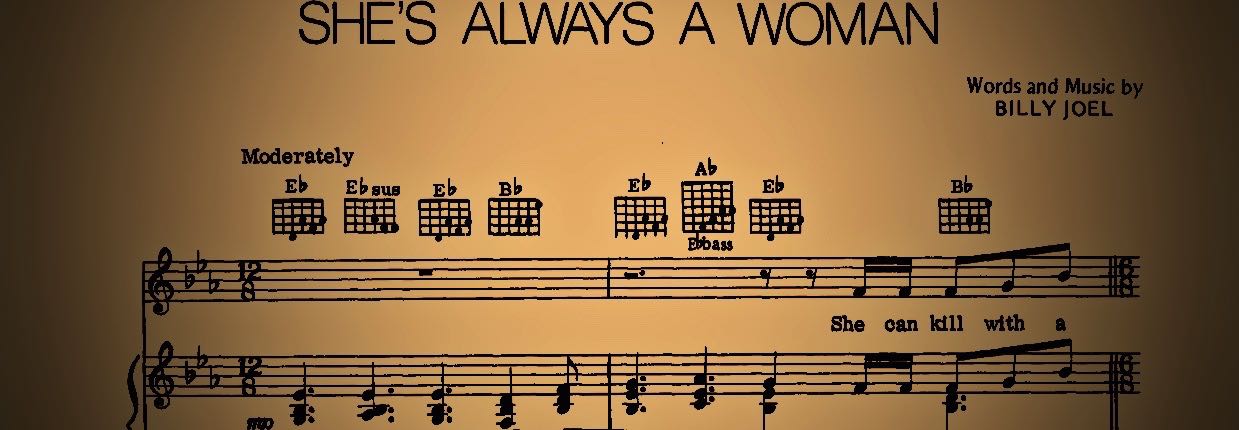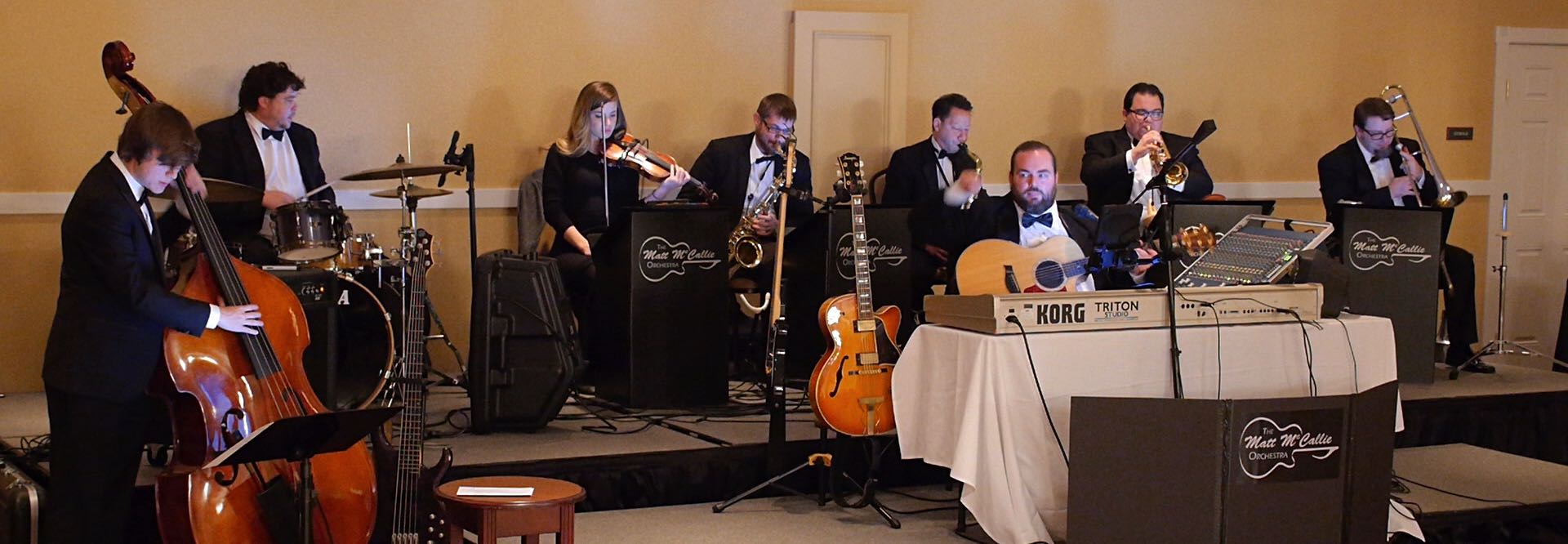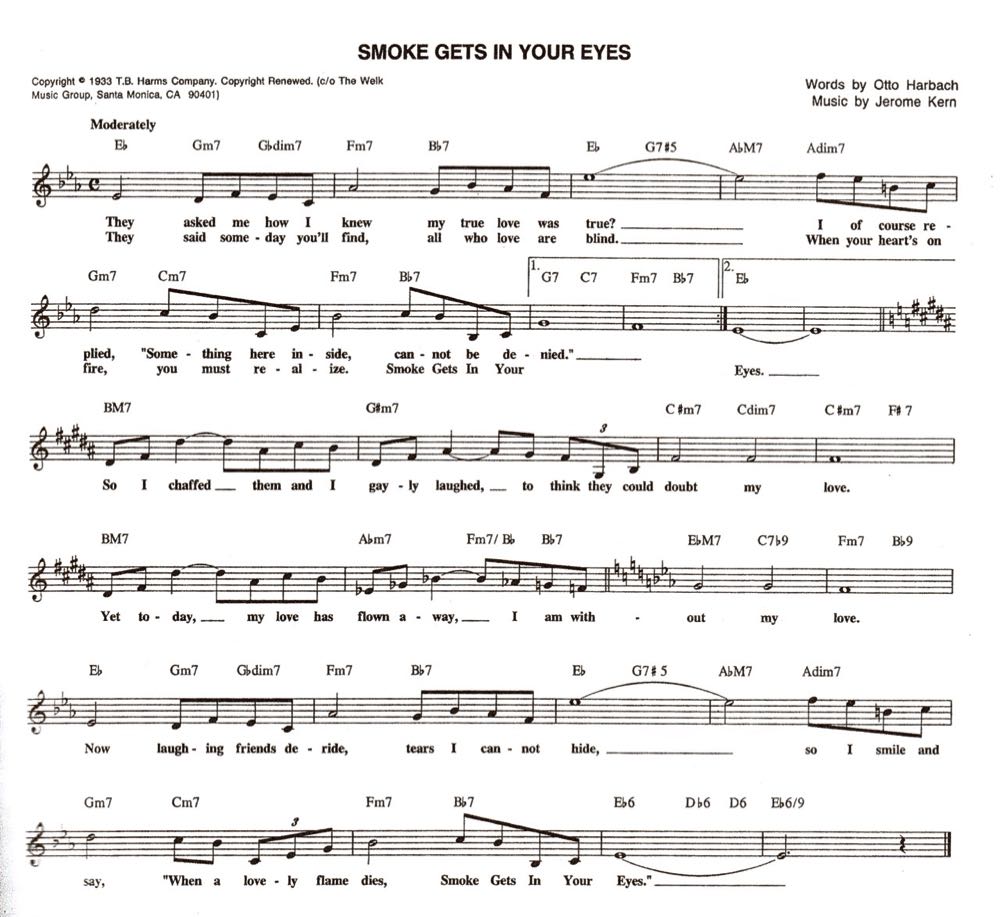
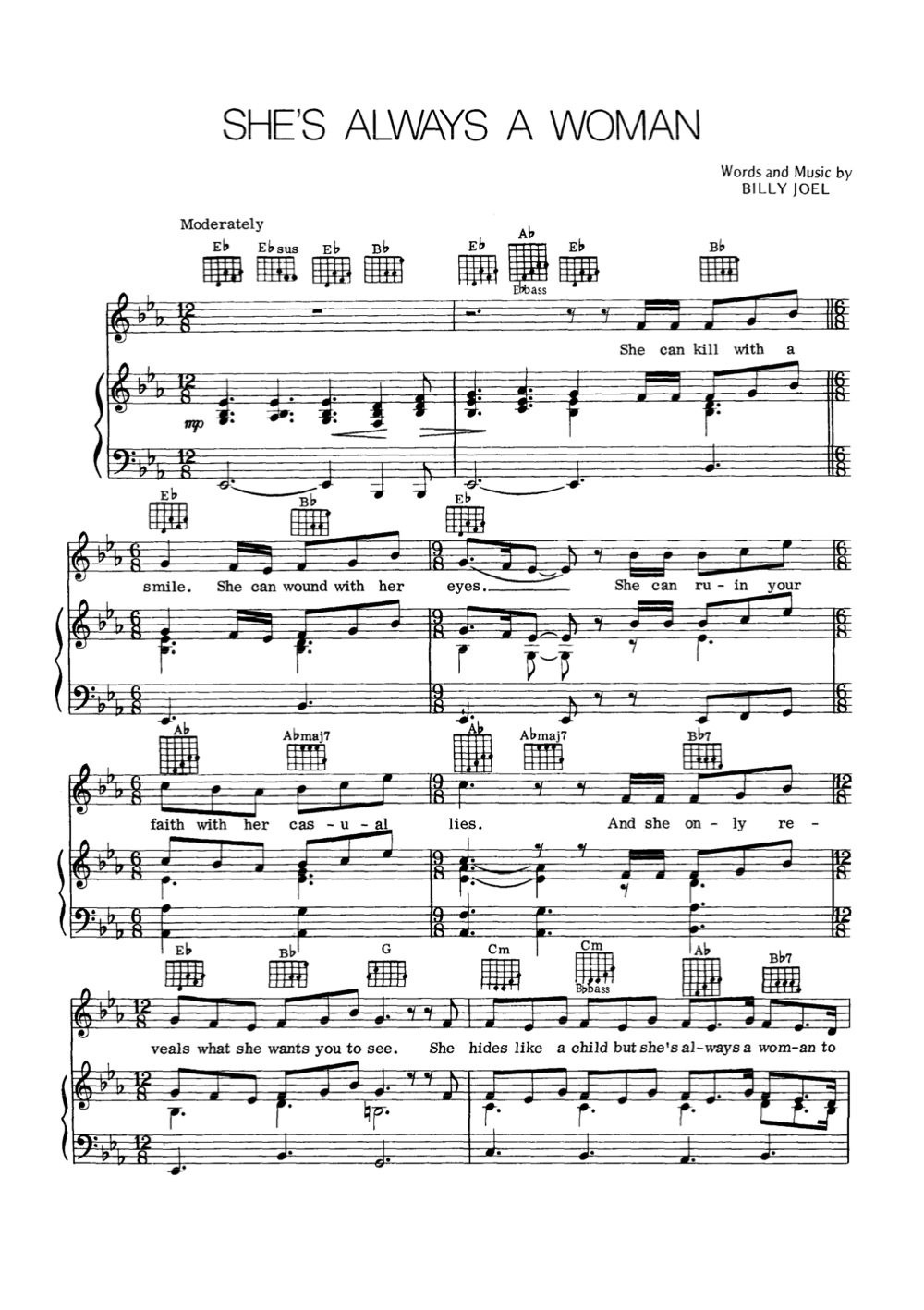
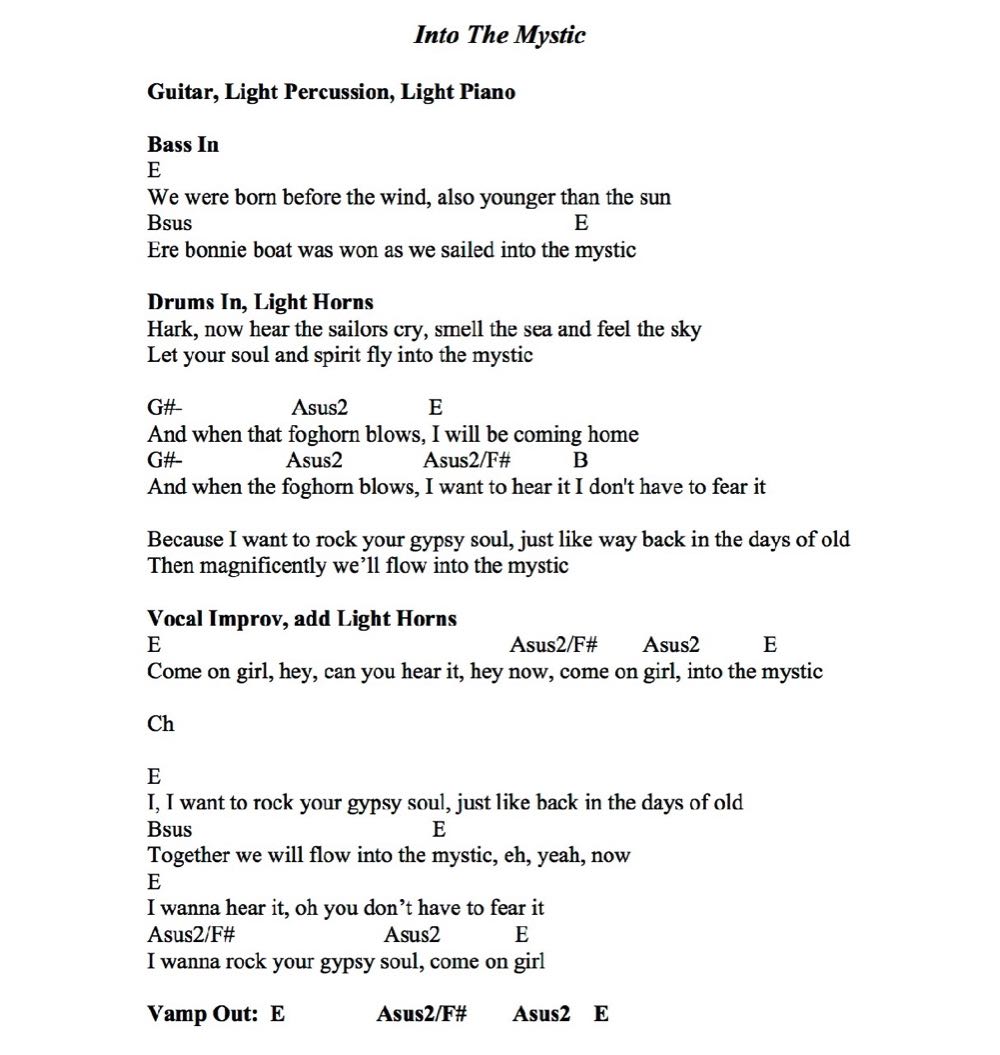
Question: What types of charts does The Matt McCallie Orchestra use?
Answer: Primarily fully notated standard music notation.
Every musician in The Matt McCallie Orchestra is highly trained and experienced. Our musicians typically have at least one degree in music. One of the requirements to be a member of this band is the ability to read music very, very well. Most of our songs are fully written out in standard music notation with different parts for every instrument. This is one of the ways in which we are able to provide a consistently expert level of live performance quality.
Standard Music Notation:
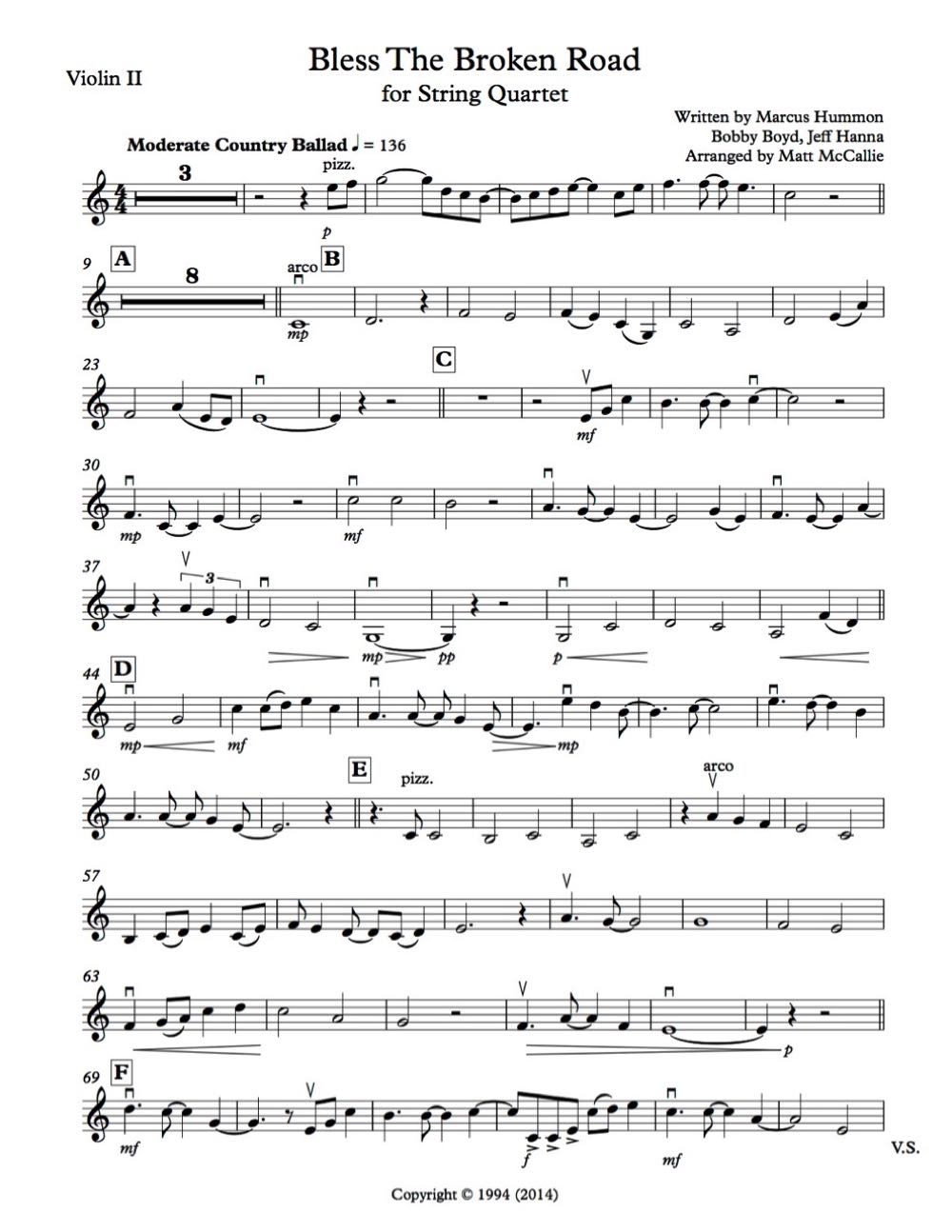
Traditional big band music is arranged for at least 18 instruments each playing a different part. Most big band and Real Book charts are written using a handwritten jazz font, which is difficult to read but something of a standard.
Our digital library has over 1,000 big band charts similar to those played by most big bands all around the world. Nearly all of those charts are fully notated with every note written out for all of the horn players.
Notation Pros:
● Every note is written out for every instrument.
● Reproduction of how the song is supposed to sound is almost guaranteed.
● Each performance of the song can be more consistent because no musicians have to guess or remember how their part is supposed to be played.
● Since each musician has their own part no score reductions are necessary.
● Cues from other instruments can be written into blank spaces of other instruments. This helps musicians follow the music even when their part is resting.
● For musicians who play multiple instruments they can read the cues for the other part within the same chart they are already reading. For example flute cues could be written into an alto sax part so one musician can play both instruments during a performance.
● If a regular band member is unable to make a gig a substitute with strong sight-reading skills can be hired at the last minute without affecting the band's sound in concert.
Notation Cons:
● Reading music requires a skill not developed by all musicians. Any professional musician should be able to read and write music.
● Instruments that read in different keys like C, Eb, Bb, alto clef, or bass clef all require the notation to be written in their key.
● Most musicians who read in transposed keys must learn to transpose to concert pitch.
Slash Notation:
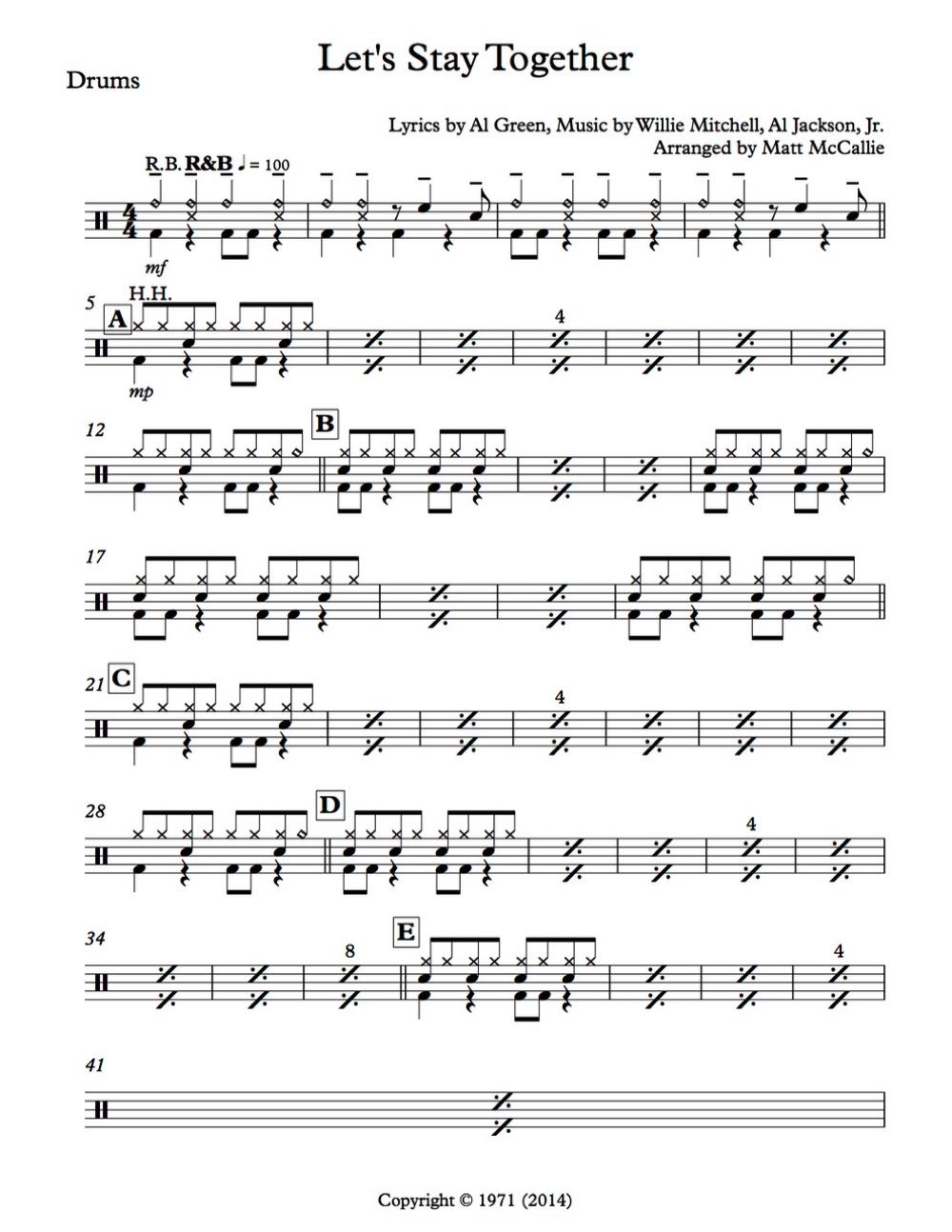
Rhythm sections in big band and other styles often employs a mix of full notation and slash notation. Slash notation literally has slashes in the measures of the music where notes would usually be written. Above the slash filled staves are chord symbols indicating the harmonic progression of the song for harmonic and melodic instruments.
Slash notation can also indicate that previous measures should be repeated. At times slash notation will include rhythmic cues but otherwise it is up to the musician to be able to interpret and improvise what they should play.
The above drum chart example demonstrates slash notation with repeat signs, indicating that both the high and low parts of each previous measure are repeated. It is also common to see slash notation that absorbs two or four measure figures.
Slash Notation Pros:
● Slashes usually take up less space in a chart and therefore fewer pages per song.
● Slash marks are easy to read.
● They allow the musician freedom to interpret how the music should be played.
● Provide rhythmic cues in their simplest form.
Slash Notation Cons:
● No pitch is written aside from a chord symbol above.
● Each performance will be interpreted by the performer, which results in less consistency in a band's sound.
● It is easier for a musician to get lost when reading a chart with all slash notation due to the lack of detail.
Head Charts:
Head charts are one of the most versatile styles of notating the very basics of a song. Head charts have a fully notated melody as well as cues for codas, repeats, dynamics, and other articulations and instructions found in standard music notation.
In addition to the melody a head chart almost always has chord changes placed above the melody. If there are lyrics those are written beneath the melody like in standard notation.
The differences between head charts and fully notated charts is that there is only one part written. No individual parts are arranged or included for multiple instruments. Chord changes are typically performed by rhythm section instruments such as guitar, bass, and piano. Drummers have to interpret what and how to play according to the grove and tempo descriptions indicated at the beginning of the chart. If there are no lyrics to be sung by a vocalist a melodic instrument like trumpet, saxophone, trombone, or violin will play the melody.
The main part of the melody in a head chart is referred to as the “head.” In jazz standards like those in fake books such as the Real Book multiple instruments may play the head simultaneously. During repeats and solo sections of the song any instruments in the ensemble may improvise, usually one musician at a time or trading on and off. “Trading fours” is a common phrase indicating that one instrument will play for four bars and switch off with another instrument for the next four bars, going back and forth between those instruments until that section of the song is completed, moving on to the next. In jazz bass and drums are most often the two instruments to trade fours.
After solos one of the musicians will point to their head, which is the cue to the rest of the band to go back to the beginning, top, or head of the chart, which they will usually play once more before ending the song.
Head charts can be used for many types of songs. Most fake books use head charts.
Head Chart Pros:
● The most identifiable aspects of a song are usually notated with cues for a melodic instrument, lyrics with the melody notated, chord changes, and sometimes some rhythmic cues.
● Head charts are tremendously reduced in how many pages the musician has to turn to read and perform the song.
● Small ensembles or even soloists who sing and play guitar, piano, or another self-accompanying chordal instrument can deliver an entire concert using head charts with enough recognizable aspects of an original recording for most puproses.
Head Chart Cons:
● There are no parts for additional instruments.
● Precise voicings, rhythms, articulations, and other musical aspects in the accompaniment are likely entirely absent.
● Head charts can be challenging for even a skilled self-accompanying singer to play and sing without any familiarity with a given song. The better a musician already knows the song, the more inflection they can add to their performance.
● Many fake books make a lot of compromises in their arrangements of head charts. A song's introductory and outro section are usually totally absent. It is rare to find solos notated that would be played by a guitar or another instrument. Sometimes the form of the song is edited and inaccurate.
PVG:
PVG is an acronym for Piano, Voice, Guitar. Similar to a head chart they provide a notated melody above the lyrics. PVG charts provide more musical detail than a head chart. They tend to have an intro and outro and likely have a solo section written out.
Something unique to PVG charts is that if the guitar played in the original recording used a capo there will often be two sets of chord symbols throughout the entire chart. One set of chords for concert C instruments like piano, one for the guitar using a capo. They are usually layered one above the other.
As with any chart that is not fully notated PVG charts have compromises.
PVG Pros:
● PVG charts have notated accompaniment throughout the chart.
● An intro and outro are included as well as a solo section.
● It is easier to have more instruments play a PVG chart because the piano notation is in treble and bass clefs so a bass player can read the lower left hand of the piano part and other instruments can read the inner parts as harmonies, provided they read in the same key.
PVG Cons:
● The piano notation is generally a score reduction meaning it is a compromise of melodic lines, string and horn parts, bass, and other instruments approximated to be played by one instrument.
● Intros, outros, solos, and other sections usually only sound similar to the original recordings due to their limitations.
● PVG charts are generally several pages long making them very difficult to read on a live gig.
● Repeats are almost always used for additional verses but the amount of notation that can be squeezed into the staff for each repeat is limited. So any differences in the piano accompaniment, chord changes, rhythmic figures, and vocal stylings likely can't be notated.
● Repeats and codas usually require leaping back and forth through the chart by multiple pages at a time.
● Verses beyond the 1st and 2nd often locate the lyrics for those verses at the end of the chart. This makes it impossible to read the words, chords, melody, and follow the form of the chart at the same time.
Lead Sheets:
Lead sheets are one of the simplest methods of notating a song. A well written lead sheet will still likely take at minimum three hours to transcribe if including methods of indicating background vocal parts and close to accurate timing of chord changes with lyrics.
Lead sheets consist of lyrics with chord changes above them to indicate when and what chords to play with the words. There is no actual notation to indicate pitch, duration, dynamics, nor any articulations. The key signature is to be ascertained from the harmonic progression unless a written description is provided. The same goes for the groove and tempo.
Lead Sheet Pros:
● Simplicity.
● Usually able to fit onto one or two pages.
● Easy to read the lyrics and chords.
Lead Sheet Cons:
● No notation equals very little musical detail. No pitch, melody, nor rhythms are provided.
● To be able to accurately play a lead sheet at least one musician in the ensemble must have great familiarity with the song so all of the other musicians can follow their lead.
Nashville Number System:
Almost exclusively used by country musicians in Nashville, Tennessee NNS is most alike a lead sheet but lacking any traditional music notation for pitch, melody, or rhythm. Often instead of chords harmonic progressions are written as numbers or Roman Numerals. While the use of Roman Numerals to indicate harmonic progressions dates back centuries, most classical musicians also used a notation when they improvised during most of their performances.
Nashville Pros:
● The system is traditional amongst country musicians particularly in the Nashville scene.
Nashville Cons:
● Lack of musical detail requires all band members to either memorize songs by listening to recordings or to learn the songs through rehearsals.
● One of the most time consuming notation methods for having a band learn to play a song.
● Requires the ability to constantly transpose chords into whatever key is being used.
● Makes complex chords like those in jazz more difficult to read.
● Cues for rhythms, dynamics, and articulations are far less descriptive and precise than full standard notation.
● Advanced notations are lacking and require communication for the song to be performed as the composer intended.
● NNS is scarcely used outside of Nashville or the country genre.
TAB or Tablatures:
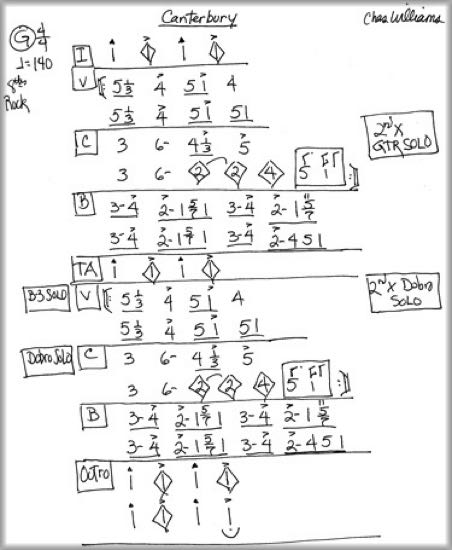
TABs are another form of a cheat sheet mostly used by non-notation literate musicians. The majority of free guitar music found online will be in the form of tablatures. Tablature is also popular for other stringed instruments including ukelele, mandolin, and banjo.
What is most unique about tablature is that instead of being pitch and or rhythm based, it is exclusive to the instrument for which it is being written. This is because tablature notates fingerings by fret number and string. Pitch is usually not referenced in tablature, only the fret number on each string. Rhythm is also ignored but the number of notes played in a measure is generally visible, though each note's duration is unknown.
To identify each pitch the reader must know the pitch of each open string in the diagram and count up from there. Each ascending whole number is a half step higher in pitch. Tablature diagrams do not use a traditional five line staff, rather a staff with the same number of lines as there are strings on the instrument.
While tablature does not provide everything a musician needs to know to play the music accurately it does provide symbols for slurs, bends, hammer-ons, and slides and can provide useful information, particularly when trying to transcribe a guitar solo. The primary use for even notation reading musicians is to learn what positions were used by the original performer. While position on the fret board may be evident, tablature again is not exact because it doesn't provide fingerings.
Tablature Pros:
● TABs help novice musicians figure out where to place their fingers on an instrument.
Tablature Cons:
● Lack of musical detail means that a musician cannot sight read and perform tablature without learning the rhythms by ear or having notation accompanying the TABs. In the example below one might posit the rhythms by the spacing between the numbers but tuplets, dotted rhythms, dynamics, up and down strokes, and other important information is not provided.
The Matt McCallie Orchestra's Arrangements:
The Matt McCallie Orchestra employs all of these types of charts except for the Nashville Number System and tablature. Most of our original arrangements are fully notated.
One of the most unique aspects of The Matt McCallie Orchestra is that we are a big band with strings, often referred to as an augmented big band. The way we are able to add strings and have them play accurately each time along with our big band is that all of their parts are fully notated.
All of our big band style charts are fully notated with some slash notation, mostly for solos and rhythm section. All Real Book charts are head charts. We also have a lot of popular head charts from fake books and lead sheets we have written over many years. Those charts are most suitable for smaller ensembles like our jazz combos and pop and rock bands. With some of those songs we can have strings or horns improvise parts they can add by ear.
No other local GB band works this hard to fully notate so much music for such a large ensemble. Some of our arrangements are written for over one hundred musicians. All of the original arrangements in our song lists that have an asterisk* are fully notated for whatever instruments play that arrangement. Our arrangements are of a top-notch professional level and play a large part in why our band sounds so consistently impressive.







